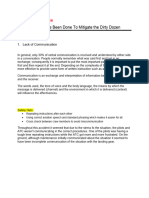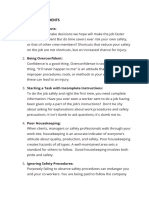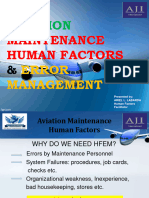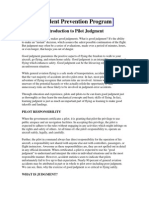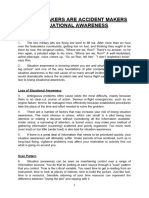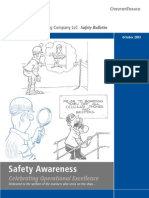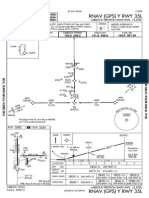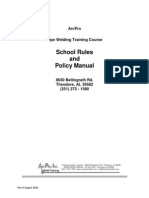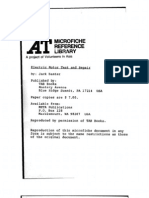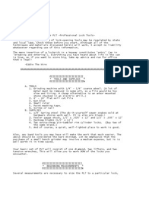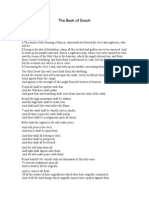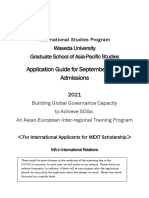0 ratings0% found this document useful (0 votes)
49 viewsSafety Compass March 2014
Safety Compass March 2014
Uploaded by
rotorbrentThe document discusses several topics related to flight safety:
1. It describes an incident where a pilot flew an aircraft with damage to the chin bubble, which violated FAA regulations. The pilot may have their license suspended as a result.
2. It discusses the top two recurring incidents in 2013 - bird strikes and leaving equipment unattached or unsecured during takeoff. Mitigation strategies are proposed for both issues.
3. Fatigue in aircraft maintenance personnel is discussed as a safety risk. Procedures to minimize risks from fatigue are recommended, including having additional technicians review work.
4. An exercise is described to demonstrate how difficult it may be to dial 911 during an emergency due to increased adren
Copyright:
© All Rights Reserved
Available Formats
Download as PDF, TXT or read online from Scribd
Safety Compass March 2014
Safety Compass March 2014
Uploaded by
rotorbrent0 ratings0% found this document useful (0 votes)
49 views5 pagesThe document discusses several topics related to flight safety:
1. It describes an incident where a pilot flew an aircraft with damage to the chin bubble, which violated FAA regulations. The pilot may have their license suspended as a result.
2. It discusses the top two recurring incidents in 2013 - bird strikes and leaving equipment unattached or unsecured during takeoff. Mitigation strategies are proposed for both issues.
3. Fatigue in aircraft maintenance personnel is discussed as a safety risk. Procedures to minimize risks from fatigue are recommended, including having additional technicians review work.
4. An exercise is described to demonstrate how difficult it may be to dial 911 during an emergency due to increased adren
Original Description:
ssafety
Copyright
© © All Rights Reserved
Available Formats
PDF, TXT or read online from Scribd
Share this document
Did you find this document useful?
Is this content inappropriate?
The document discusses several topics related to flight safety:
1. It describes an incident where a pilot flew an aircraft with damage to the chin bubble, which violated FAA regulations. The pilot may have their license suspended as a result.
2. It discusses the top two recurring incidents in 2013 - bird strikes and leaving equipment unattached or unsecured during takeoff. Mitigation strategies are proposed for both issues.
3. Fatigue in aircraft maintenance personnel is discussed as a safety risk. Procedures to minimize risks from fatigue are recommended, including having additional technicians review work.
4. An exercise is described to demonstrate how difficult it may be to dial 911 during an emergency due to increased adren
Copyright:
© All Rights Reserved
Available Formats
Download as PDF, TXT or read online from Scribd
Download as pdf or txt
0 ratings0% found this document useful (0 votes)
49 views5 pagesSafety Compass March 2014
Safety Compass March 2014
Uploaded by
rotorbrentThe document discusses several topics related to flight safety:
1. It describes an incident where a pilot flew an aircraft with damage to the chin bubble, which violated FAA regulations. The pilot may have their license suspended as a result.
2. It discusses the top two recurring incidents in 2013 - bird strikes and leaving equipment unattached or unsecured during takeoff. Mitigation strategies are proposed for both issues.
3. Fatigue in aircraft maintenance personnel is discussed as a safety risk. Procedures to minimize risks from fatigue are recommended, including having additional technicians review work.
4. An exercise is described to demonstrate how difficult it may be to dial 911 during an emergency due to increased adren
Copyright:
© All Rights Reserved
Available Formats
Download as PDF, TXT or read online from Scribd
Download as pdf or txt
You are on page 1of 5
UNCOMPROMISING COMMITMENT TO SAFETY
WORLD CLASS PATIENT CARE
MARCH 2014
1
SAFE -vs- AIRWORTHY
Dwain McDonald
BAM, Beaumont TX (Ret.)
We had received a call to transfer a patient from the Port Arthur,TX. medical center to the medical center in
Houston. At approximately 0345 hrs. the patient was loaded on the aircraft. After my walk-around
inspection, I climbed in, strapped in and put on my helmet and prepared to start the aircraft. Before I could
start the aircraft the med crew announced the patient was coding and they were going to move him back to
the ER. As I was taking off my helmet I heard a bang and someone say Im sorry. I looked down and saw a
hole approximately 2 by 5 in the pilot chin bubble. The ER nurse had run the stretcher into the chin bubble.
I exited the aircraft and called the mechanic and explained what happened and the damage done to the
aircraft. I told the mechanic to start the procedure to get us a new chin bubble. I told him I would take the
aircraft back to our base which is about a 4 minute flight. This is where I went wrong. My definition of
airworthy means the aircraft is safe to fly. However airworthy according to the FARs means that the
damage has been written up in the logbook, properly serviced and signed off by maintenance and returned
to service. Also, a request for a one time flight must be made to the FAA if it needs to be repositioned for
repair. This incident is still under investigation by the FAA and I stand a chance of having my license
suspended for a period of time. Bottom line: If the aircraft sustains any damage whatsoever, no matter how
minor you may think it is, leave it where you had it parked and let maintenance do their job.
Are We There Yet?
After much research, comparing and contrasting, all
four companies came to the same conclusion:
Baldwin Aviation is the vendor we want to partner
with for safety reporting.
Expect changes to how we
report things starting in April.
First it will be safety reporting, next, the flight risk
assessment then other reports and forms. Every
employee will have visibility on the risks at their
base and across the company. If you havent
watched the Baldwin training videos on
Cornerstone, now would be a good time.
No Really, Are We There Yet?
Final stages of polishing the Safety Manual are
almost complete. Changes you will see from the
2014 Safety Initiatives
old way of doing things:
A formalized Just Culture
program, implemented
consistently across all four
companies
A Med-Trans Time-Out
Policy to provide all
employees with a tool to
prevent bad situations
from becoming worse.
Localizing the Safety Compass. Get our programs
involved to host a month of Safety Compass to share
their safety efforts.
UNCOMPROMISING COMMITMENT TO SAFETY
WORLD CLASS PATIENT CARE
MARCH 2014
2013 started off with the tragic accident in Mason City IA, but thankfully ended
peacefully. Tracking our top two recurring incidents, we have a near tie between bird
strikes (8) and leaving stuff on, attached to, or unsecure on Takeoff (7). Lets discuss
mitigation for these two types of events.
Bird Strikes
There isnt much we can do to prevent birds from
operating in our airspace. So mitigation is best
addressed by what we can do to ensure the safety of
everyone on board should one crash your party. A
bird strike through the windscreen can be a
catastrophic event, and aircraft control could be lost,
making recovery difficult or impossible given the
time you have to react. 92% of bird strikes occur in
the airspace we typically operate in (below 3500
AGL)
Mitigation strategy
1 Helmet visor down or glasses on during the day
2 Clear visor down at night unless NVGs are worn.
3 Scan 45 degrees either side of the nose in your
flight path, slightly above to slightly below flight
level
4 Dont rely on the birds instinct to dive as you
approach it, be prepared to perform
evasive action to avoid a collision
5 Quiz yourself periodically in flight:
What actions would I take and
where would I land if I lost my
engine(s)right now?
6 If the pilot needed my help, what
could I could I do to ensure a successful PL?
Pre-Flight Misses:
Urgency yes, rushing, no. There is no substitute for
attention to detail. Unfortunately, attention to
detail falls victim to rushing every time. In 2013,
we took off at least seven times with aircraft
unprepared for flight. Whether it was a door left
ajar, a seat belt hanging out of the aircraft or
needed equipment left on the pad or falling off in
flight.
In 2014, lets not charge the hill until we are ready:
Crew in sync, aircraft prepared for flight,
Required equipment on board, nothing left behind,
everything secure.
Mitigation strategy
As our new policy states, after everything and everyone
else has boarded, one person is responsible for making
sure that nothing was left out, on, attached to the
aircraft, and panels and doors are secure.
There is no excuse for taking off before you and
your aircraft are ready to fly.
2
UNCOMPROMISING COMMITMENT TO SAFETY
WORLD CLASS PATIENT CARE
MARCH 2014
3
I ask this question to myself as much as my fellow
maintenance technicians. Is today the day that being
tired or preoccupied results in an accident or
incident?
Take a minute and think back on the mistakes youve
made in your career.how many where due to being
tired or preoccupied with another matter. I would
hazard a guess, more than half.
On December 7
th
2011 N37SH, a Eurocopter AS350-B2
crashed with tragic consequences, the loss of five lives
and the destruction of the aircraft. NTSB Aircraft
Accident Report PB2012-103890 dated January 29
th
2013 cited four areas in the cause of the accident:
Improper re-use of used self-locking hardware
Maintenance personnel fatigue
Lack of procedures outlining the maintenance tasks
Lack of human factors training by the company
The work environment for mechanics in the EMS field
is not conducive to a steady work schedule so
maintaining your aircraft can involve some fatigue. In
the accident investigation it was noted that the
maintenance personnel
had been called in early to work and presumed to be
tired which started the chain of events. So what can
we do to minimize the risk when called in?
First is to follow all procedures associated with the
task at hand, short cuts or procedures handed down
through generations are not worth the time saved if
an incident occurs.
Second have an extra pair of eyes check your work,
explain the task steps and verify all FOD and tools are
removed. If the second pair of eyes is tired, get a
third. In the Eurocopter accident, the Quality
Assurance mechanic was also tired and overlooked
the errors.
Third, review common maintenance task and standard
practices, standards may have changed.
Fourth, knowledge is power. Study Human Factors in
aviation maintenance and pay attention to what your
body is telling you, taking a break to refresh your mind
may be all it takes to break the chain of events.
The responsibility we hold as mechanics should not be
thought of lightly, the lives of all who fly in your tail
number currently and years to come rely on what we
do today. BE SAFE, AND KEEP THEM IN THE AIR.
IS TODAY THE DAY?
Eric M. Smyth
Lifeguard Base Mechanic
Cedar Rapids IA
UNCOMPROMISING COMMITMENT TO SAFETY
WORLD CLASS PATIENT CARE
MARCH 2014
4
HOW FAST CAN YOU DIAL 911?
How many pushes does it take on your cellphone to dial 911? And how long do you think it would take
to correctly input those selections in an emergency, with adrenaline dumping into your bloodstream?
Try this little exercise. Do 20 pushups as fast as you can, then immediately grab your cell phone, punch
in your security code, go to the dial pad and type in 911. How fast were you able to do it? If you cant
do 20 pushups, that is a separate issue that involves a gym membership.
If you have never been in a life or death situation, its easy from your
armchair to assume that you would be able to focus your attention
and deftly input the correct numbers in the correct sequence. That is a
bad assumption. When your mind perceives a mortal threat to your
safety, fight or flight physiology take over. The fight or flight response is
our body's primitive, automatic, inborn response that prepares the body
to "fight" or "flee" from perceived attack, harm or threat to our survival.
Symptoms include:
All symptoms that make dialing 911 from a cellphone more difficult. Smart phones are taking over as
the go-to device to keep us connected to our world. So why not use technology to compensate for
physical shortcomings? Why not employ your phone to increase your safety and security posture?
There are many apps available, three of which are shown below as representative examples. While
Safety Compass does not endorse any product, our crack team of researchers found all three to be
well designed and surprisingly simple to operate, even under the life and death stress ofpushups.
On-Watch 911 imsafe
5
UNCOMPROMISING COMMITMENT TO SAFETY
WORLD CLASS PATIENT CARE
MARCH 2014
You might also like
- "How To Murphy-Proof Your Life": If Anything Can Go Wrong, It WillDocument4 pages"How To Murphy-Proof Your Life": If Anything Can Go Wrong, It WillrotorbrentNo ratings yet
- Death of An Airline Exercise 2 - Dirty Dozen Safety NetsDocument10 pagesDeath of An Airline Exercise 2 - Dirty Dozen Safety NetsAmreen DhillonNo ratings yet
- 19 Tips para Los Pilotos AviadorsDocument13 pages19 Tips para Los Pilotos AviadorsJose Luid SagastumeNo ratings yet
- Probable Hazard in AviationDocument6 pagesProbable Hazard in AviationPrinnia Zulfiqur BorshaNo ratings yet
- Aviation Human Factors Industry News 05Document22 pagesAviation Human Factors Industry News 05Adriano MoralesNo ratings yet
- Causes and Prevention of IncidentsDocument19 pagesCauses and Prevention of IncidentsmrankhubiduNo ratings yet
- General Port Safety and Security Information 2012 PDFDocument26 pagesGeneral Port Safety and Security Information 2012 PDFShahrul ShafiqNo ratings yet
- Essencial Safety Tips For Helicopter PilotsDocument2 pagesEssencial Safety Tips For Helicopter PilotsJose Luid SagastumeNo ratings yet
- "To Err Is Human ": AccountabilityDocument4 pages"To Err Is Human ": AccountabilityrotorbrentNo ratings yet
- Chapter 7 Close Protection TeamworkDocument47 pagesChapter 7 Close Protection TeamworkLemur CattaNo ratings yet
- Accident Investigation GuideDocument4 pagesAccident Investigation GuideWahyudi YudiNo ratings yet
- 2019 - 05 Safety MeetingDocument2 pages2019 - 05 Safety MeetingEarl Tito JohnsonNo ratings yet
- 'Report A Near-Miss - Save A Life' ReferenceDocument38 pages'Report A Near-Miss - Save A Life' ReferenceJoseph Gracious100% (1)
- Good Pilot Decision MakingDocument9 pagesGood Pilot Decision Makingluishz25iphoneNo ratings yet
- Human Factor Training MaterialAVIAAJI For MoodleDocument125 pagesHuman Factor Training MaterialAVIAAJI For MoodleDorian MartinezNo ratings yet
- Group 10 - TPDocument5 pagesGroup 10 - TPJayce SiosonNo ratings yet
- BECOME A FLIGHT ATTENDANT: Your flight to successFrom EverandBECOME A FLIGHT ATTENDANT: Your flight to successRating: 3 out of 5 stars3/5 (7)
- Safety Orientation HandbookDocument18 pagesSafety Orientation HandbookHarley añanaNo ratings yet
- Concise Guide To Safe FlyingDocument35 pagesConcise Guide To Safe Flyingairbuk doeingNo ratings yet
- HSE Course ContentsDocument29 pagesHSE Course ContentsfawnNo ratings yet
- Occupational Health and Safety Training-1Document45 pagesOccupational Health and Safety Training-1Adel valensNo ratings yet
- Accident Prevention Program: Introduction To Pilot JudgmentDocument5 pagesAccident Prevention Program: Introduction To Pilot JudgmentSherif Riad100% (1)
- Flight Op Management MIDTERM TPDocument5 pagesFlight Op Management MIDTERM TPAnatano NamaewaNo ratings yet
- Safety in Aircraft Maintenance PDFDocument27 pagesSafety in Aircraft Maintenance PDFAbdAllah Ezz100% (1)
- Measuring Our Safety-Ness: by David Carr Director of SafetyDocument4 pagesMeasuring Our Safety-Ness: by David Carr Director of SafetyrotorbrentNo ratings yet
- Midterm Seatwork #1Document2 pagesMidterm Seatwork #1Charlene SibayanNo ratings yet
- 90 Days To 94% Fewer Fatigue Events: Fatigue Management Case StudyDocument7 pages90 Days To 94% Fewer Fatigue Events: Fatigue Management Case Studymario alejandroNo ratings yet
- 1972 4 EngDocument15 pages1972 4 EngTateNo ratings yet
- Accident InvestigationsDocument21 pagesAccident InvestigationsChandan KumarNo ratings yet
- The Human Factors - Dirty Dozen - SKYbrary Aviation SafetyDocument5 pagesThe Human Factors - Dirty Dozen - SKYbrary Aviation SafetySuman Bajracharya100% (1)
- Hfpa Chapter 4Document27 pagesHfpa Chapter 4Mehroob CheemaNo ratings yet
- Management 1Document4 pagesManagement 1Brendan Rezz R CilotNo ratings yet
- Flight Safety Article FLT LT SoumitraDocument4 pagesFlight Safety Article FLT LT SoumitraSälmän Md ÄhsänNo ratings yet
- Industrial Accident and SafetyDocument64 pagesIndustrial Accident and Safetychandan914100% (1)
- Yourcompany: Safety and Loss Control ProgramDocument21 pagesYourcompany: Safety and Loss Control ProgramCeline SamonteNo ratings yet
- Behaviour Based Safety: Background of BBSDocument6 pagesBehaviour Based Safety: Background of BBSAbhinav MehraNo ratings yet
- Good Decisions On The Fly: Putting TEM On Your Safety TeamDocument11 pagesGood Decisions On The Fly: Putting TEM On Your Safety TeamJenny' Peña MtzNo ratings yet
- Error Traps: How High-Performing Teams Learn To Avoid Mistakes in Aircraft MaintenanceFrom EverandError Traps: How High-Performing Teams Learn To Avoid Mistakes in Aircraft MaintenanceRating: 5 out of 5 stars5/5 (2)
- Army Aviation Digest - May 1994Document56 pagesArmy Aviation Digest - May 1994Aviation/Space History LibraryNo ratings yet
- Safety Awareness: Celebrating Operational ExcellenceDocument8 pagesSafety Awareness: Celebrating Operational ExcellenceMario AndrewNo ratings yet
- Common Safety MistakesDocument5 pagesCommon Safety Mistakesmaakafaith87No ratings yet
- Safety At: Are ForDocument5 pagesSafety At: Are Forphuocsang4278No ratings yet
- Doucette - Patient and Airline SafetyDocument5 pagesDoucette - Patient and Airline SafetysuaadNo ratings yet
- Expect The Unexpected: Evidence-Based TrainingDocument4 pagesExpect The Unexpected: Evidence-Based Trainingdionicio perezNo ratings yet
- Chap 4 AppendixDocument16 pagesChap 4 Appendixdryef1212No ratings yet
- Expect The Unexpected Evidence Based TrainingDocument5 pagesExpect The Unexpected Evidence Based TrainingagallopezNo ratings yet
- Operational Threat and Error Management Ver 11Document29 pagesOperational Threat and Error Management Ver 11pei372175% (4)
- 2 CRMDocument24 pages2 CRMrozhinhadi63No ratings yet
- Construction APPSampleDocument72 pagesConstruction APPSamplealbert john oliveraNo ratings yet
- Human Factors Contribute To Near MishapDocument2 pagesHuman Factors Contribute To Near MishapRohit YadavNo ratings yet
- WB Unit 5 Comy Fly With UsDocument4 pagesWB Unit 5 Comy Fly With UsNastya Volod'koNo ratings yet
- Navfac Safety Handbook Dec2012Document86 pagesNavfac Safety Handbook Dec2012AjishNo ratings yet
- AC759 - AC Personnel Interview SummaryDocument73 pagesAC759 - AC Personnel Interview SummaryGFNo ratings yet
- CP 4 Oup Safety at WorkDocument7 pagesCP 4 Oup Safety at WorkAlwiRizalNo ratings yet
- Confined Space Program - Questions & Answers: B A C K G R o U N DDocument5 pagesConfined Space Program - Questions & Answers: B A C K G R o U N DIndranil MitraNo ratings yet
- Element 4Document4 pagesElement 4Malcolm ThompsonNo ratings yet
- 1 - ATP Pilot 1st Set of QuestionsDocument15 pages1 - ATP Pilot 1st Set of QuestionsPettNo ratings yet
- Safety MomentDocument37 pagesSafety MomentMohd Tarique100% (1)
- Edu AdebolaDocument5 pagesEdu Adebolaoladimejifaisol075No ratings yet
- Stop BP Gupco-ModifiedDocument20 pagesStop BP Gupco-ModifiedAhmed HashimNo ratings yet
- Oldier Onors Rogram and Ospital With Riceless Ift: S H P H P GDocument8 pagesOldier Onors Rogram and Ospital With Riceless Ift: S H P H P GrotorbrentNo ratings yet
- "To Err Is Human ": AccountabilityDocument4 pages"To Err Is Human ": AccountabilityrotorbrentNo ratings yet
- Measuring Our Safety-Ness: by David Carr Director of SafetyDocument4 pagesMeasuring Our Safety-Ness: by David Carr Director of SafetyrotorbrentNo ratings yet
- KLBB Rnav (GPS) 35lDocument1 pageKLBB Rnav (GPS) 35lrotorbrentNo ratings yet
- "Sugar N Spice ": - One of These Is Not Like The Other (Part I)Document5 pages"Sugar N Spice ": - One of These Is Not Like The Other (Part I)rotorbrentNo ratings yet
- School Rules and Policy Manual: ArcproDocument13 pagesSchool Rules and Policy Manual: ArcprorotorbrentNo ratings yet
- Tradition Meet Practical DriftDocument6 pagesTradition Meet Practical DriftrotorbrentNo ratings yet
- Have Iphone - Will Travel: Beware, Tunnel Vision AheadDocument6 pagesHave Iphone - Will Travel: Beware, Tunnel Vision AheadrotorbrentNo ratings yet
- Trimble 2101 ManualDocument243 pagesTrimble 2101 ManualrotorbrentNo ratings yet
- Electric Motor Test RepairDocument160 pagesElectric Motor Test Repairrotorbrent100% (2)
- The Dutch Oven CookbookDocument53 pagesThe Dutch Oven CookbookCrisNo ratings yet
- How To Make Professional Lock Pick ToolsDocument5 pagesHow To Make Professional Lock Pick Toolsvinekm6100% (6)
- Book of EnochDocument77 pagesBook of EnochrotorbrentNo ratings yet
- RSA - Training ManualDocument47 pagesRSA - Training ManualasfsdfgrehdtrhvbNo ratings yet
- CHAPMAN-2003-An Introduction To The RMA PDFDocument21 pagesCHAPMAN-2003-An Introduction To The RMA PDFBrenda de KassiaNo ratings yet
- Mext Gsaps 2021.09 Ma Applicationguide EngDocument34 pagesMext Gsaps 2021.09 Ma Applicationguide EngabidafifaNo ratings yet
- Amber Mckees ResumeDocument1 pageAmber Mckees Resumeapi-602848447No ratings yet
- CVTemplate en GBDocument2 pagesCVTemplate en GBdoinadoinitaNo ratings yet
- Historical and Descriptive Research DesignsDocument4 pagesHistorical and Descriptive Research Designsaidavon_27100% (1)
- Assignment 4 Sakshi Fatnani, Furniture DesignDocument15 pagesAssignment 4 Sakshi Fatnani, Furniture DesignSakshi FatnaniNo ratings yet
- Declaration Jamie Fox 2020-06-11Document27 pagesDeclaration Jamie Fox 2020-06-11mikekvolpeNo ratings yet
- PTPTN ONLINE APPLICATION GUIDELINES FAQ - Updated 4 May 2021Document16 pagesPTPTN ONLINE APPLICATION GUIDELINES FAQ - Updated 4 May 2021RICH FXNo ratings yet
- Class XI The Summer of The Beautiful White Horse - CBSE Sample QuestionsDocument3 pagesClass XI The Summer of The Beautiful White Horse - CBSE Sample QuestionsRicha Mahajan30% (10)
- Noam Chomsky's Theory of NativismDocument17 pagesNoam Chomsky's Theory of NativismSumithra Krishnan100% (3)
- Excursion Parent Consent Form - 2021 VSSECDocument8 pagesExcursion Parent Consent Form - 2021 VSSECFelix LeNo ratings yet
- Department of Education: Republic of The PhilippinesDocument1 pageDepartment of Education: Republic of The Philippinesfrancisco s.destura jrNo ratings yet
- Jurnal-Understanding Consumer'sDocument19 pagesJurnal-Understanding Consumer'sSurya SuryaNo ratings yet
- Any FourDocument17 pagesAny FourMeraj HaseenNo ratings yet
- 14.guided Reading Lesson Plan ExampleDocument2 pages14.guided Reading Lesson Plan ExampleJoaquinNo ratings yet
- Advertising TheoryDocument22 pagesAdvertising Theoryvvasimm6413No ratings yet
- Cost FordDocument12 pagesCost FordGurpreet KaurNo ratings yet
- Research On The Dimensions and Path Selection of Enterprise Performance Evaluation Under Balanced ScorecardDocument4 pagesResearch On The Dimensions and Path Selection of Enterprise Performance Evaluation Under Balanced ScorecardBhavish RamroopNo ratings yet
- The Role of E Commerce in Improving Customer SatisfactionDocument6 pagesThe Role of E Commerce in Improving Customer SatisfactionEditor IJTSRDNo ratings yet
- Components of ResearchDocument5 pagesComponents of ResearchNĩhãd MãlįkNo ratings yet
- Getting Grounded On AnalyticsDocument31 pagesGetting Grounded On AnalyticsIvan Jon Ferriol100% (2)
- Cyber Security For Your Organisation Starts Here: Further InformationDocument6 pagesCyber Security For Your Organisation Starts Here: Further Informationlalou4No ratings yet
- Top Two Underground Traffic Sources v2Document5 pagesTop Two Underground Traffic Sources v2Josiah MwashitaNo ratings yet
- Cot - DLP - Science 5 by Sir John Cel P. FaustinoDocument3 pagesCot - DLP - Science 5 by Sir John Cel P. FaustinoGlenn Cacho Garce100% (1)
- World ReligionsDocument257 pagesWorld ReligionsRolant95% (19)
- Integrating The Local and ContemporaryDocument3 pagesIntegrating The Local and ContemporaryJescelyn VillaramNo ratings yet
- Meyer v. Nebraska Case DigestDocument2 pagesMeyer v. Nebraska Case DigestAshreabai Kam SinarimboNo ratings yet
- Murga Thematic UnitDocument5 pagesMurga Thematic Unitapi-566995581No ratings yet
- Ra 8551 and 6975Document64 pagesRa 8551 and 6975Djpreciouslove Viernes100% (4)

